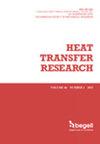不同纳米流体的内向挡板对圆柱形水平管道层流强制对流加热的影响
IF 1.6
4区 工程技术
Q3 THERMODYNAMICS
引用次数: 0
摘要
提高热交换强度是热交换器行业的一个主要目标。使用挡板是实现这一目标的技术之一。在这项数值研究中,针对纳米流体的情况,处理了在圆柱形水平管道壁上放置内向挡板的影响。除了在一定程度上填补了文献中关于不同形状挡板对纳米流体的影响的空白之外,还提供了一个顺序分析,以更好地理解不同的影响及其后果,特别是对平均交换率的影响。研究分为三个部分,10Re250,首先是无挡板管道的情况,在此处理水基纳米流体效应。考虑了体积浓度为 0j10% 的三种纳米粒子(Cu、Al2O3 和 TiO3)。为确保在假设温度下加热管入口处的动态建立,放置了一个绝缘的初级管道。结果表明,与基础流体相比,添加纳米颗粒后,运动粘度和热扩散率的改变对动态长度和热长度分别产生了明显的影响。提出了确定这两个参数的相关性。根据记录,随着体积浓度的增加,热交换率也会提高,特别是对于热导率较高的纳米粒子。在第二部分中,假定加热管中存在矩形挡板,并分别分析了其位置、长度和宽度的影响。结果表明,将挡板放置在靠近入口的位置更有意义,尤其是当挡板较长时。在工作的最后一部分,提出了其他三种形状的挡板(梯形、三角形和椭圆形)。结果证实,非光滑形状的障板会在动态和热场中产生更多干扰,因此热交换率会有更大的提高。对于后两个部分,纳米流体的效果与无挡板管道的效果相似。本文章由计算机程序翻译,如有差异,请以英文原文为准。
Effect of an inward-facing baffle on the laminar forced convection heating along a cylindrical horizontal pipe for different nanofluids
Improving heat exchange intensity is a major goal in the heat exchanger industry. The use of baffles is one of the techniques employed to achieve this goal. In this numerical work, the effect of an inward-facing baffle placed on the wall of a cylindrical horizontal pipe is treated for the case of nanofluid. A sequential analysis is offered to better understand the different effects and their consequences, particularly on the average exchange rate, in addition to somewhat filling the gap identified in the literature for the case of nanofluid with various shapes of the baffle. The study, divided into three parts, begins for 10Re250 with the case of pipe without baffle, where the water-based nanofluid effect is treated. Three types of nanoparticles (Cu, Al2O3 and TiO3) at volume concentration 0ϕ10% are considered. An insulated primary pipe is placed to ensure dynamic establishment at the entrance to the heating pipe assumed to be under imposed temperature. The results showed the clear effects of modifying the kinematic viscosity and thermal diffusivity on the dynamic and thermal lengths respectively with the addition of nanoparticles compared to the base fluid. Correlations are proposed for their determination. A heat exchange rate that improves as the volume concentration increases is recorded, particularly for nanoparticles with high thermal conductivity. In the second part, a rectangular baffle is assumed in the heated pipe, where the effects of its position, length and width are analyzed respectively. The results showed a greater interest in placing the baffle close to the entrance, especially if it is longer. In the last part of the work, three other shapes of the baffle are proposed (Trapezoidal, Triangular and Elliptical). The results confirm that the non-smooth shape of the baffle creates more disturbances in the dynamic and thermal fields, and therefore a greater improvement in the heat exchange rate. For the last two parts, the nanofluid effect remains similar to that recorded for pipe without baffle.
求助全文
通过发布文献求助,成功后即可免费获取论文全文。
去求助
来源期刊

Heat Transfer Research
工程技术-热力学
CiteScore
3.10
自引率
23.50%
发文量
102
审稿时长
13.2 months
期刊介绍:
Heat Transfer Research (ISSN1064-2285) presents archived theoretical, applied, and experimental papers selected globally. Selected papers from technical conference proceedings and academic laboratory reports are also published. Papers are selected and reviewed by a group of expert associate editors, guided by a distinguished advisory board, and represent the best of current work in the field. Heat Transfer Research is published under an exclusive license to Begell House, Inc., in full compliance with the International Copyright Convention. Subjects covered in Heat Transfer Research encompass the entire field of heat transfer and relevant areas of fluid dynamics, including conduction, convection and radiation, phase change phenomena including boiling and solidification, heat exchanger design and testing, heat transfer in nuclear reactors, mass transfer, geothermal heat recovery, multi-scale heat transfer, heat and mass transfer in alternative energy systems, and thermophysical properties of materials.
 求助内容:
求助内容: 应助结果提醒方式:
应助结果提醒方式:


